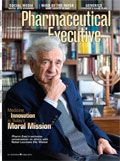Digital Alternatives Define New Sales Force
Pharmaceutical Executive
Teams must adapt techniques to embrace new technologies in order to remain successful
Consensus is growing that today's pharmaceutical sales forces must be revamped into smaller, more flexible, and science-based groups. As reps undergo this fundamental change, they must also change their tools and techniques. This includes medical speaker programs, which will have to evolve to stay relevant in the new world of pharma sales.

Bill Cooney
Following decades of growth that peaked in 2007, speaker program activity has fallen sharply over the last two years, down by 30 percent or more at most pharma companies. This has occurred even though speaker programs, when done right, are among the best examples of pharma programming, beneficial to the medical community and addressing the core need of clinicians to learn more about medical advances directly from esteemed peers.
Speaker programs are in decline due to the same forces that are currently reshaping all areas of pharma sales: cost, regulations, and access to healthcare professionals. If speaker programs are to resume their place as primary channels for peer-based marketing, the format must change in response to this new environment.
While almost all major trends in the medical marketplace are now adverse, one trend that is favoring speaker programs is the boom in digital media. Clinicians of all types are accessing various websites as their primary source for medical information in daily practice. To survive, speaker programs must leverage this phenomenon.
There are many ways to do this. Several pharma companies have piloted programs featuring speakers at video studios, broadcasting over the Web to audiences gathered at restaurants or hotels. These programs have been successful in various ways, save one: They haven't generated any cost savings. Other programs have been designed to connect with several hundred target clinicians in a single, live, Web-based event. This format can lower costs, but too often has failed to reach attendance goals.
An alternative Web-based format is desktop-to-desktop (D2D) speaker programs designed around small groups, brief sessions, and a large number of scheduled events. This format avoids the expense of studios and venues, and provides more flexible audience reach compared with one-time "big event" webcasts.
Digital alternatives for speaker programs must address the various forces that are redefining the pharma sales force, as follows:
Cost Control
The new economics of healthcare have caused every major pharma company to undertake unprecedented measures to cut marketing costs. Local speaker events are a major area of spend, and costs often fall in a range of $400 to $600 per attendee. Unfortunately, the studio-to-venue webcast model does not provide lower costs compared to local events. The D2D format substantially lowers costs by eliminating facility and A/V equipment expenses at studios and venues, as well as major dining costs. This can result in substantial savings of 70 percent to 80 percent.
Tougher Regulations
The D2D format is inherently compliant with various regulations that have targeted "transfers of value," including meals, with spending caps, reporting requirements, and a ban on meals at venues in two states, Massachusetts and Vermont. D2D speaker programs can be implemented with no meals and no reporting requirements for attendees. Looking ahead, this is of great importance considering the pending Physician Payment Sunshine Act (PPSA), which will require medical product companies to report payments of money or gifts, including the value of meals, made to individual physicians.
Engaging the Audience
Almost all HCPs prefer active over passive learning formats, and virtual speaker events must actively involve target audiences. Webconference platforms offer various interactive functions such as audience polling, response meters, and texting for questions and comments. Skillful use of these tools can produce a virtual meeting experience that engages the intellect of participants, potentially changing their beliefs and behaviors. As a practical matter, it helps to keep group sizes in a range of six to 12 people, so that everyone can pose questions and comments.
A Dynamic Experience
There's nothing like the immediacy of an in-room speaker, and as speaker programs move into digital media, it's important to compensate for the loss of face-to-face contact. Webconference platforms support a host of multimedia features that can combine to deliver a great program experience. Effective preparation, founded in an understanding of digital media and instructional design, is essential to deliver a superior D2D speaker session. This includes elements such as live video of speakers, dynamic slide design, and live markups, such as arrow pointers. The technical quality and practicality of these tools is constantly improving, so that effective multimedia can bring a virtual meeting to life.
The Right Content
As pharma sales forces evolve away from overt promotion and towards a focus on science, so too must program content evolve. To bring real value to clinicians, virtual speaker programs need to address evidence-based medicine and other relevant clinical topics. Of course, these topics can include an appropriate role for sponsor products and brand messages, but the core content must first and foremost address clinician needs. It also helps to engage the best speakers, and the logistics of virtual programs makes it possible to concentrate activity in the hands of a smaller group of the most respected key opinion leaders.
Making It Work
Perhaps nothing is more critical to the success of a virtual speaker program than sales force buy-in. Too often, virtual speaker events have been one-off or short-lived programs, fairly viewed by sales reps as creating more complications than benefits. Virtual speaker initiatives need to be carefully planned and methodically rolled out with sales rep orientation sessions that clearly communicate program plans and logistics. The virtual speaker channel must also be positioned as a permanent addition to the sales rep's tool set, one that will help reps deliver value, gain physician access, and reach sales goals.
Even with so many market forces arrayed against them, speaker programs have a strong role in medical marketing. An SK&A survey in 2008 showed that 80 percent of physicians welcome pharma speaker programs, reflecting the strong benefit clinicians perceive in live peer-to-peer events. Speaker programs are worth saving, and must move away from dining venues and into digital media to survive in the new medical landscape.
Bill Cooney is President and CEO of MedPoint Communications. He can be reached at bill.cooney@medpt.com
